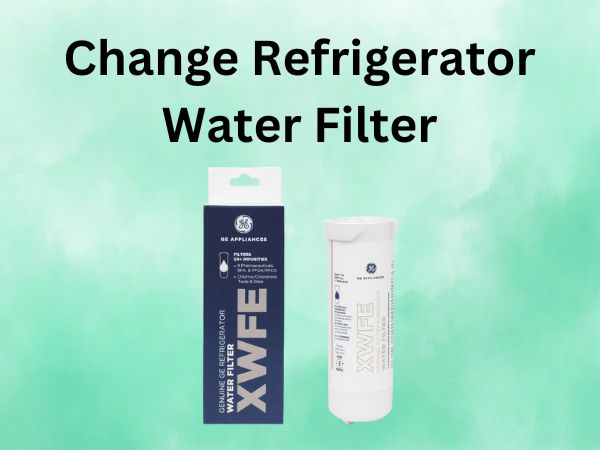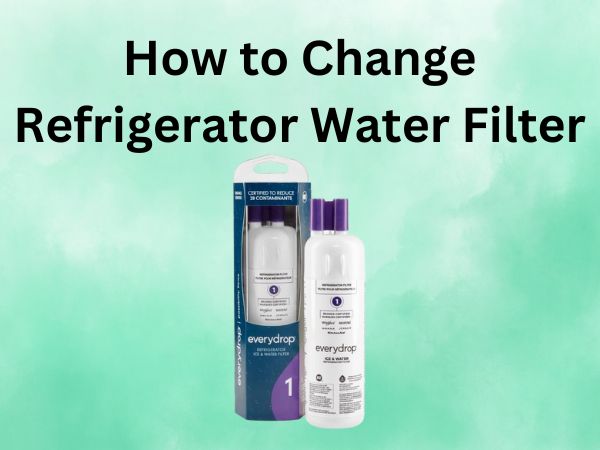How to Change Refrigerator Water Filter [Ultimate Guide]
Changing the water filter in your refrigerator is a simple task that can have a significant impact on the quality of your drinking water and the overall performance of your appliance. Over time, water filters can become clogged with sediments, contaminants, and impurities, leading to a decrease in water flow and potentially affecting the taste and odor of your water. Replacing the filter regularly is essential to ensure you and your family are enjoying fresh, clean water while also extending the lifespan of your refrigerator.
Table of Contents
Why Change Your Refrigerator Water Filter?
Improved Taste and Odor
One of the primary reasons to change your refrigerator water filter is to improve the taste and odor of your drinking water. As the filter becomes saturated with contaminants, it can no longer effectively remove substances that impart unpleasant flavors or smells. By replacing the filter, you’ll instantly notice a fresher, cleaner taste in your water.
Reduced Contaminants
Water filters are designed to remove a variety of contaminants from your water supply, including chlorine, lead, and other potentially harmful substances. Over time, the filter’s ability to remove these contaminants decreases, allowing them to pass through and potentially impact your health. Changing the filter regularly ensures that you and your family are drinking the cleanest water possible.
Prolonged Appliance Life
In addition to providing clean water, changing your refrigerator water filter can also help extend the life of your appliance. A clogged or overused filter can restrict water flow, causing additional strain on the refrigerator’s internal components. By replacing the filter as recommended, you’ll ensure optimal water flow and reduce the risk of premature wear and tear on your refrigerator.
Preparation
Before you begin the process of changing your refrigerator water filter, it’s important to gather the necessary tools and materials, and locate the filter compartment.
Gather Necessary Tools and Materials
New Water Filter
First and foremost, you’ll need a new water filter that is compatible with your specific refrigerator model. Check your owner’s manual or consult with the manufacturer to ensure you purchase the correct replacement filter.
Towels
Have a few clean towels or rags on hand to catch any spills or drips that may occur during the filter change process.
Bucket (optional)
If your refrigerator’s water filter is located in a tight space or an awkward position, you may find it helpful to have a small bucket or container nearby to catch any water that may spill out when you remove the old filter.
Locate the Water Filter Compartment

Check the User Manual
Refer to your refrigerator’s user manual for specific instructions on locating the water filter compartment. Most manufacturers provide detailed diagrams and instructions to help you find the filter’s location.
Common Filter Locations
While the exact location may vary depending on your refrigerator model, some common places to look for the water filter include:
- Inside the refrigerator compartment, often located in the top right or left corner
- Behind the refrigerator’s kick plate or grille at the bottom
- In the back of the refrigerator, accessible from the rear panel
With your tools and materials gathered, and the filter compartment located, you’re now ready to begin the process of changing your refrigerator water filter.
Step-by-Step Guide
Now that you’ve gathered the necessary tools and located the water filter compartment, it’s time to dive into the step-by-step process of changing your refrigerator water filter.
Turn Off the Water Supply
Before removing the old filter, it’s crucial to turn off the water supply to your refrigerator. This will prevent any potential water leaks or spills during the filter change process.
- Locate the water supply valve for your refrigerator, which is typically located behind the appliance or under the kitchen sink.
- Turn the valve clockwise to shut off the water supply completely.
Remove the Old Filter
With the water supply turned off, you can now safely remove the old water filter from your refrigerator.
Twist and Pull
Most refrigerator water filters are designed to be easily removed by twisting them counterclockwise and then pulling them straight out.
- Grasp the filter firmly and twist it to the left (counterclockwise) until it becomes loose.
- Once loose, gently pull the filter straight out of its housing.
Note: Some filters may be secured with a release button or latch. Consult your owner’s manual for specific instructions on how to release your particular filter.
Check for Leaks
After removing the old filter, take a moment to inspect the area for any water leaks or spills. If you notice any moisture, use your towels or rags to clean it up before proceeding.
Insert the New Filter
With the old filter removed and any leaks cleaned up, it’s time to install the new water filter.
Align and Push
- Remove the new filter from its packaging, making sure to follow any specific instructions provided by the manufacturer.
- Align the new filter with the housing, ensuring that it is properly oriented.
- Once aligned, firmly push the filter into the housing until it clicks or locks into place.
Check for Proper Installation
After inserting the new filter, double-check to ensure it is securely installed and seated correctly in its housing. Consult your owner’s manual if you’re unsure about the proper installation procedure.
Flush the Water Lines
With the new filter in place, it’s essential to flush the water lines to remove any air or residual contaminants that may have accumulated during the filter change process.
Dispense Water
- Turn the water supply valve back on, allowing water to flow into your refrigerator’s water system.
- Dispense water from the refrigerator’s water dispenser or ice maker, allowing it to run for several minutes until it flows smoothly without any sputtering or air bubbles.
Check for Leaks Again
After flushing the water lines, carefully inspect the area around the new filter for any signs of leaks or drips. If you notice any moisture, turn off the water supply and ensure the filter is properly installed before trying again.
By following these step-by-step instructions, you’ve successfully changed your refrigerator water filter, ensuring that you and your family can enjoy fresh, clean drinking water while also prolonging the life of your appliance.
Maintenance and Best Practices
Changing your refrigerator water filter is an essential part of maintaining your appliance and ensuring you have access to clean, fresh drinking water. However, it’s important to establish good habits and follow best practices to maximize the effectiveness of your new filter and avoid future issues.
Set a Reminder
One of the most important things you can do is to set a reminder to change your water filter on a regular basis. Most manufacturers recommend replacing the filter every six months or after a certain number of gallons have been dispensed (typically around 300-500 gallons).
There are several ways to set a reminder:
- Mark your calendar: As soon as you install a new filter, make a note on your calendar or set a recurring reminder six months from that date.
- Use your smartphone: Many smartphones have built-in reminder apps or calendar features that allow you to set recurring reminders for tasks like changing your water filter.
- Subscribe to a filter replacement service: Some companies offer subscription services that will automatically send you new filters on a schedule, ensuring you never forget to change them.
Keep a Filter Log
Another helpful practice is to keep a log of when you change your water filter. This can be a simple notebook or spreadsheet where you record the date, the filter model number, and any relevant notes (e.g., water flow issues, unusual tastes or odors).
Maintaining a filter log can help you:
- Identify patterns or issues that may require further troubleshooting or maintenance.
- Ensure you’re using the correct filter model for your refrigerator.
- Keep track of how often you’re changing the filter, which can help you adjust your reminder schedule if needed.
Check for Manufacturer’s Recommendations
While most refrigerator water filters have a recommended replacement interval of six months, it’s always a good idea to check your specific manufacturer’s recommendations. Some factors, such as the size of your household or the quality of your water supply, may affect how often you need to change the filter.
Additionally, some manufacturers may have specific guidelines or best practices for maintaining their water filters, such as flushing the system after installation or performing periodic cleaning or sanitization procedures.
By following these maintenance and best practices, you’ll ensure that your refrigerator water filter is performing at its best, providing you and your family with clean, fresh drinking water while also protecting your appliance from potential damage caused by a clogged or overused filter.
FAQs
How often should I change my refrigerator water filter?
Most manufacturers recommend changing the water filter every six months or after a certain number of gallons have been dispensed (typically around 300-500 gallons). However, it’s always a good idea to check your specific manufacturer’s recommendations, as the replacement interval may vary based on factors like household size and water quality.
What happens if I don’t change my water filter regularly?
If you don’t change your water filter regularly, it can become clogged with sediments, contaminants, and impurities, leading to decreased water flow, unpleasant tastes and odors, and potentially affecting the performance of your refrigerator. Additionally, a clogged filter may allow contaminants to pass through, which could impact your health.
Can I use a generic water filter instead of the manufacturer’s recommended filter?
While generic water filters may be more affordable, it’s generally recommended to use the filter model specified by your refrigerator’s manufacturer. Generic filters may not be designed to fit or function properly with your specific appliance, which could lead to water leaks, decreased performance, or even damage to your refrigerator.
How do I know if my water filter needs to be changed?
There are a few signs that may indicate it’s time to change your water filter, such as decreased water flow from the dispenser or ice maker, unpleasant tastes or odors in the water, or the filter indicator light (if your refrigerator has one) turning on or flashing.
Can I reuse a water filter?
No, water filters are designed for single-use only and should be replaced with a new filter once they have reached their recommended lifespan or capacity. Attempting to reuse a water filter can lead to decreased performance, potential contamination, and may even damage your refrigerator’s water system.
Conclusion
Changing your refrigerator water filter is a simple task that can have a significant impact on the quality of your drinking water and the overall performance of your appliance. By following the step-by-step guide provided in this article, you can easily replace your old filter with a new one, ensuring that you and your family are enjoying fresh, clean water while also extending the lifespan of your refrigerator.
Remember to gather the necessary tools and materials, locate the water filter compartment, turn off the water supply, remove the old filter, insert the new filter, and flush the water lines. Additionally, establish good maintenance habits by setting reminders, keeping a filter log, and checking for manufacturer’s recommendations.
By taking these proactive steps, you’ll not only enjoy the benefits of clean, fresh drinking water but also protect your investment by keeping your refrigerator in top working condition.


![The 10 Best Sink Faucet Water Filters [IN 2025]](https://bathroomexplorer.com/wp-content/uploads/2024/04/Best-Sink-Faucet-Water-Filters.jpg)
![10 Best Frigidaire Refrigerator Water Filters [In 2025]](https://bathroomexplorer.com/wp-content/uploads/2024/04/Best-Frigidaire-Refrigerator-Water-Filter.jpg)
![What Is The Best Heavy Duty Suction Grab Bars [IN 2025]](https://bathroomexplorer.com/wp-content/uploads/2024/04/Best-Heavy-Duty-Suction-Grab-Bars.jpg)
![3 Stage Vs 4 Stage Reverse Osmosis Filtration [in 2024]](https://bathroomexplorer.com/wp-content/uploads/2023/10/3-Stage-Vs-4-Stage-Reverse-Osmosis-Filtration-768x461.jpg)
![The 10 Best Water Filter Pitchers [IN 2025]](https://bathroomexplorer.com/wp-content/uploads/2024/04/Best-Water-Filter-Pitchers.jpg)